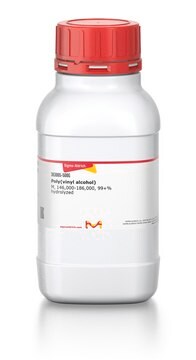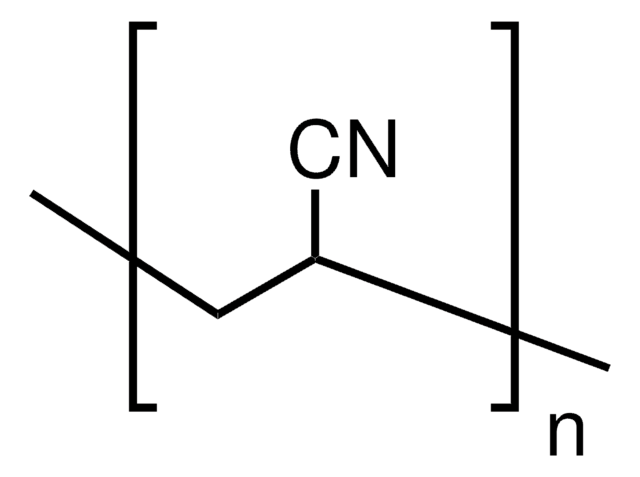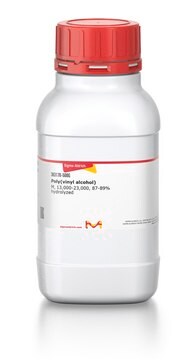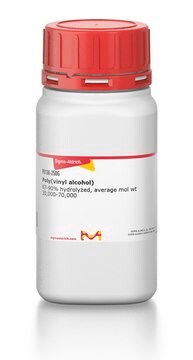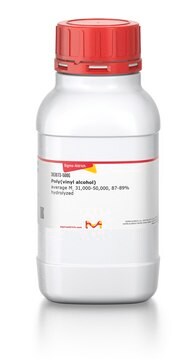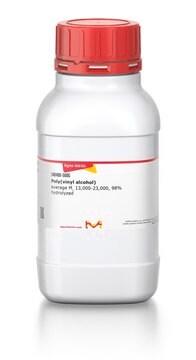Wszystkie zdjęcia(2)
Key Documents
363103
Poly(vinyl alcohol)
average Mw 146,000-186,000, 87-89% hydrolyzed
Synonim(y):
PVA
Zaloguj sięWyświetlanie cen organizacyjnych i kontraktowych
About This Item
Polecane produkty
Poziom jakości
Postać
powder or crystals
masa cząsteczkowa
average Mw 146,000-186,000
Spadająca piłka
40-50 cP, 4 % in H2O(20 °C)(lit.)
InChI
1S/C2H4O/c1-2-3/h2-3H,1H2
Klucz InChI
IMROMDMJAWUWLK-UHFFFAOYSA-N
Szukasz podobnych produktów? Odwiedź Przewodnik dotyczący porównywania produktów
Opis ogólny
Poly(vinyl alcohol) (PVA) is a vinyl based water soluble polymer that can be used as a non-ionic surface active agent. It can also be used as a biodegradable polymer and can be incorporated in adhesives, coatings, textiles, ceramics and cosmetics. Its properties include good transparency, chemical resistance, toughness and anti-electrostatic properties.
Zastosowanie
PVA can be used in the preparation of hydrogel templates for drug delivery applications. It can also be used in the development of organic memory systems.
This page may contain text that has been machine translated.
Kod klasy składowania
11 - Combustible Solids
Klasa zagrożenia wodnego (WGK)
WGK 1
Temperatura zapłonu (°F)
No data available
Temperatura zapłonu (°C)
No data available
Środki ochrony indywidualnej
Eyeshields, Gloves, type N95 (US)
Wybierz jedną z najnowszych wersji:
Masz już ten produkt?
Dokumenty związane z niedawno zakupionymi produktami zostały zamieszczone w Bibliotece dokumentów.
Klienci oglądali również te produkty
Coexistence of Write Once Read Many Memory and Memristor in blend of Poly (3, 4-ethylenedioxythiophene): polystyrene sulfonate and Polyvinyl Alcohol
Nguyen VC and Lee PS
Scientific Reports, 6(1-2), 38816-38816 (2016)
Compostable Polymer Properties and Packaging Applications
Plastic Films in Food Packaging, 217-248 (2013)
Biodegradation of poly (vinyl alcohol) based materials
Chiellini E, et al.
Progress in Polymer Science, 28(6), 963-1014 (2003)
Gang Wang et al.
PloS one, 6(11), e27605-e27605 (2011-11-24)
Mucosal vaccination has been demonstrated to be an effective means of eliciting protective immunity against aerosol infections of foot and mouth disease virus (FMDV) and various approaches have been used to improve mucosal response to this pathogen. In this study
Miao Zhang et al.
Journal of visualized experiments : JoVE, (73)(73), e4335-e4335 (2013-03-15)
Existing protocols for the generation of neurons from human pluripotent stem cells (hPSCs) are often tedious in that they are multistep procedures involving the isolation and expansion of neural precursor cells, prior to terminal differentiation. In comparison to these time-consuming
Nasz zespół naukowców ma doświadczenie we wszystkich obszarach badań, w tym w naukach przyrodniczych, materiałoznawstwie, syntezie chemicznej, chromatografii, analityce i wielu innych dziedzinach.
Skontaktuj się z zespołem ds. pomocy technicznej
